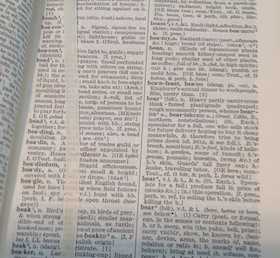In my first post, I noted that the words granite and corn share the Latin root granum, granite for its granular texture and corn for its original meaning as the local grain crop, whatever it might be. I recently learned that pomegranate also shares this root, and the pomegranate itself has a fascinating history to boot.
The pomegranate (or its wild progenitors) probably came from somewhere in central Asia, but it moved quickly along trade routes to the Levant and beyond. It was called malum Punica, the apple of Carthage, for its association with Carthaginian traders.1 The English word pomegranate comes from the medieval Latin pomum granatum, the grained apple; this name refers to the granular look of the many seeds packed inside the fruit. Scientists today call the pomegranate Punica granatum. In French, it is la grenade, and the word grenade was also given to the military device, presumably for some visual resemblance to the fruit.
The pomegranate became widely cultivated in Spain after Abd Al-Rahman fled Damascus when his family’s Umayyad dynasty collapsed in the eighth century CE and eventually (sometimes in great difficulty) made his way to the Iberian peninsula. He founded a Muslim dynasty that ruled much of Iberia for nearly 300 years, and the pomegranate, a familiar food of his home, became part of the culture of Iberia. The Emirate of Granada was named for the pomegranate (granada in Spanish) and was the last part of the peninsula to fall to the Catholic Spanish. Today, of course, Granada is the name of a Spanish province and its capital city.
The official symbol of Granada, Spain is the pomegranate. In fact, the pomegranate has a rich and lengthy history of symbolic meaning worldwide. It represents fertility in many cultures, for example, and it is central to the Greek myth of Persephone.
Early in 1492, Granada fell to Ferdinand II of Aragon and Isabella I of Castile, who thus ended Muslim rule in the Iberian peninsula. Their daughter, Katherine of Aragon, married the English king Henry VIII; as her heraldic symbol, she chose the pomegranate, which represents her Spanish origins and perhaps, poignantly, her hopes for fertility. Pomegranates are still placed on her grave in Peterborough Cathedral.
I learned the story of the pomegranate’s transplantation to Spain, and the stories of many other foods and spices traded along the spice routes, in Gary Paul Nabhan’s excellent Cumin, Camels, and Caravans: A Spice Odyssey. I highly recommend this book if you’re interested in food, travel, history, or botany.
1 The Latin word malum, or apple, meant more than just the apples we know; it was also used as a generic word for fruit. ↩
